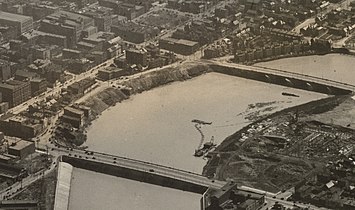Columbus Civic Center (Ohio)


1988-proposed boundaries and properties marked in red; see also
map of riverfront parks
The Columbus Civic Center is a civic center, a collection of government buildings, museums, and open park space in Downtown Columbus, Ohio. The site is located along the Scioto Mile recreation area and historically was directly on the banks of the Scioto River.
The civic center includes
Following a local version of the
Historic district
The Columbus Civic Center Historic District is a
The historic district's nomination to the National Register of Historic Places was prepared in the late 1980s by the City of Columbus's Economic Development Division. The district was determined to be eligible for the National Register on September 14, 1988, due to its association with community planning, engineering, government, and transportation in the city, and for its Art Deco, Neoclassical, and Renaissance Revival architecture.[4] Even though its suitability was confirmed, the district was never listed.[3]
History
When Columbus was founded, the only planned green spaces downtown were around the Ohio Statehouse and in front of the
Following a local version of the
The old Columbus City Hall was destroyed in a fire in 1921, allowing a new city hall to be built within the new civic center. In 1923, architect Frank Packard began a new civic center plan. He was Columbus's most prominent architect at the time, and organized the Allied Architects Association of Columbus to work on the civic center plan. Packard died later that year while working on the plan, before any of its buildings were built. The bridges, and other riverfront structures were already under construction or complete, but it led to the city planning its police station there, as well as an office building for state departments, and later the federal government moving its post office and courthouse from its former Capitol Square location to the new civic center.[3] In 1924, Central High School opened, the first building built along the river since the 1908 plan was published. The school was designed following the plan, and its stone facade and scale acted as a link between the planned government buildings on the east bank with the school on the west.[7][8] The site's government buildings were built next, between 1926 and 1934. Other government buildings, offices, and museums have been built in the civic center in years since.
Gallery
-
Riverside condition in 1908
-
Illustration of the 1908 civic center proposal
-
C. 1923, as the riverfront cleanup began
-
Columbus Dispatchin 1926, urging more prompt redevelopment
-
The completed civic center, 1936
-
Historical marker
-
Plaque commemorating the civic center, bridges, and related riverfront improvements
References
- ISBN 9781468518962. Archivedfrom the original on November 5, 2021. Retrieved May 24, 2020.
- ^ "Archived copy". Archived from the original on 2021-11-05. Retrieved 2021-11-05.
{{cite web}}: CS1 maint: archived copy as title (link) - ^ a b c d "National Register of Historic Places Registration Form". National Park Service. 2016. Archived from the original on March 22, 2020. Retrieved May 24, 2020.
- ^ a b "Main Street Dam Removal & Scioto Greenways Feasibility Study". Stantec. 2012. pp. 14–15. Retrieved December 16, 2022.
- ^ Motz, Doug (August 10, 2011). "History Lesson: The Downtown Columbus Riverfront". Columbus Underground. Archived from the original on June 23, 2017. Retrieved April 27, 2020.
- ^ a b Seymour, Jon (April 2, 2020). "Weird Columbus History: The Ohio Departments of State Building Explosion". Columbus Navigator. Archived from the original on April 27, 2020. Retrieved May 25, 2020.
- ^ a b National Register of Historic Places Registration Form. File Unit: National Register of Historic Places and National Historic Landmarks Program Records: Ohio, 1964 - 2013. National Park Service. Archived from the original on November 5, 2021. Retrieved May 24, 2020.
- ^ Carlson, Wayne (2016). "Frank L. Packard". Grandview Heights/Marble Cliff Historical Society. Archived from the original on February 4, 2020. Retrieved May 25, 2020.








